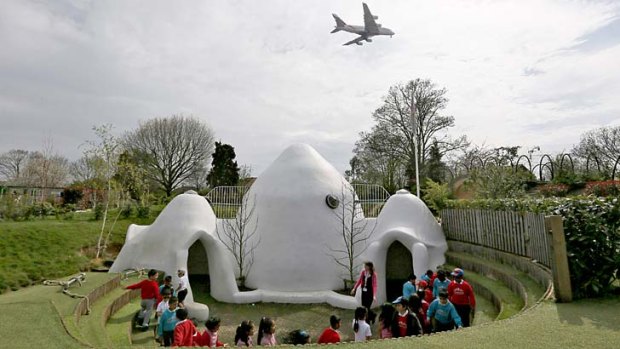This was published 10 years ago
Domes beat the noise from the world's busiest international airport

Hounslow Heath infants' school is directly under the flight path of Heathrow's southern runway and outside play for the children is interrupted every two minutes or so by landing aircraft passing over their heads.Credit: Reuters
Pupils at a London school so close to Heathrow airport that it sometimes seems descending planes might land in the playground have found a novel way to fight the roar of jet engines.
Hounslow Heath infants' school has erected four igloo-like adobe domes in its grounds, of a type normally used in earthquakes and emergency zones, to muffle the noise.
The playground is directly under the flight path of Heathrow's southern runway and outside play for the children is interrupted every two minutes or so by landing aircraft passing over their heads.

The domes, an invention of Iranian architect Nader Khalili, were originally meant for lunar settlements and were first employed in a refugee crisis after the 1990-91 Gulf war, but they work just fine for kids in west London too.Credit: Reuters
"When children were playing outside, they had nowhere to go - they were subjected to that noise," said the school's principal Kathryn Harper-Quinn.
The domes, an invention of Iranian architect Nader Khalili, were originally meant for lunar settlements and were first employed in a refugee crisis after the 1990-91 Gulf war, but they work just fine for kids in west London too.
"For play time it's fantastic that they have somewhere to withdraw - even the ones that are too young to articulate that they're feeling concerned about the noise," Harper-Quinn said.
The domes have no doors so are an open space but with a "strong psychological and physical barrier" against the noise, she said.
She estimates that when outside, teachers are inaudible to pupils for 25 seconds in every 90 because of the jets.
"You can still hear the planes in the huts but you can also hear your own voice," she said.
The school teaches 520 infants aged between three and seven and its experiment with the domes has prompted others in the area to consider following suit.
Planes pass just 180 metres over the area and their engines emit a noise level of 87 decibels.
Sound tests inside the domes showed a noise reduction of over 17 decibels and a considerable reduction in the duration of the noise, according to the website of Small Earth which makes the structures.
SUSTAINABLE
The domes, which have also been installed in the Himalayan foothills of Nepal, are made out of bags of coiled earth tubes in an igloo-shape.
The technology avoids using expensive construction materials and the cost of transporting them.
"I can carry a three-bedroomed house on my back," said Julian Faulkner, chief executive of Small Earth. "A couple of rolls of barbed wire and a roll of tubing and you're there!"
Soil dug from the construction site is compressed into tubular bags which are laid one on top of the other to form walls.
Barbed wire is placed between the layers to hold the bags together. The bags are laid in a circle with a decreasing diameter of the rows towards the top.
Aircraft noise is a thorny political issue in Britain as the government of Conservative Prime Minister David Cameron ponders where and how to expand airport capacity.
Business leaders and airlines are pressing him to expand Heathrow, a move which would affect the 750,000 people living under the flight path.
Options for increasing capacity at London Heathrow airport include a third runway and allowing planes to land and take-off on its two runways at the same time instead of the current alternating pattern.
"Having quiet time is absolutely critical. To lose runway alternation would be a disaster," said Harper-Quinn.
Reuters
Sign up for the Traveller Deals newsletter
Get exclusive travel deals delivered straight to your inbox. Sign up now.